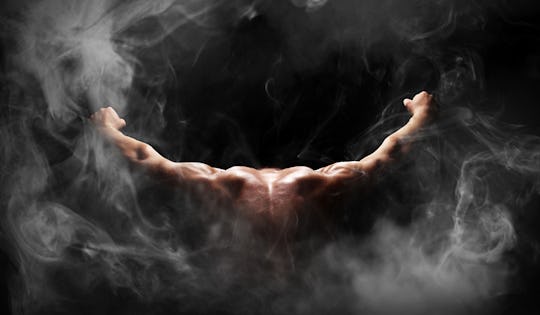Turning bright red is a normal side effect of getting hot and bothered.
As our skin gets warmer then the air around us the body begins taking some drastic measures to cool down. During exercise, the human body can produce enough energy to power the lights in your home. This rise in internal temperatures triggers the body to start cooling itself off. This effect is exponentially increased to those athletes living in the south. While performing physical activity in extreme humidity, sweating may be even less effective since perspiration can’t evaporate and cool the skin. If you’re exercising and it’s sticky out, a glistening red glow may be the skin’s only way to regulate temperature.
The majority of gym goers associate sweating and turning tomato red as just another miserable experience connected with exercise, but it is a very complex process within the human body and when understood; could take your training to the next level. The human body’s process of cooling down is called thermoregulation. Thermoregulation is imperative for the body to reach homeostasis. Homo Sapiens adaptation to varying climatic conditions is a result of physiological mechanisms resulting from evolution and behavioral mechanisms resulting from conscious cultural adaptations. The body as four cooling mechanisms it implements to regulate homeostasis.
Body Cooling Effect #1: Perspiration/Evaporation
The most obvious way for the body to cool itself down is perspiration. Perspiration or sweating is the process in which a large number of glands beneath the surface of the skin, within the entire body begin to secrete moisture. In cold weather the arteries and veins nearer the skin have less blood passing through them than the arteries and veins further into the body, thereby retaining heat. The hairs on most parts of your body also stand up to trap a layer of air for insulation. In warm weather the hairs lie down and the arteries and veins nearer the skin fill up thereby letting heat energy radiate out of the body. This action allow the body’s pores to secrete sweat which acts as a cooling agent.
Although this process may help you feel cooler, it has a limited effect on lowering the body’s internal temperature levels on its own. The secondary branches of the cardiovascular system dilate wide open, pulling away from the body’s core toward the surface of the skin. The body is mostly concerned with keeping the brain and internal organs as cool as possible, by allowing hot blood to travel away from the core toward the extremities. The blood underneath the skin is cooled by means of an endothermic reaction, allowing the sweat to evaporate. This transfer of matter from liquid to a vaporous state requires heat energy. This energy is drawn from the surrounding atmosphere, namely the body. Heat is pulled out of the nearby blood and skin, allowing the body to cool.
Body Cooling Effect #2: Radiation
Radiative cooling is the process by which a body loses heat by thermal radiation. Radiation is a form of heat loss through infrared rays, which involves the transfer of heat from one object to another without physical contact. While the body is at rest, the body’s primary method for discharging heat is radiation. The skin is constantly radiating heat in all directions towards the objects adjacent to it, such as clothing or furniture. The body can also receive heat from objects around it through radiation if those objects happen to be warmer than the body.
Body Cooling Effect #3: Conduction
Conduction is the process of losing heat through physical contact with another object or body. You may experiencethis process when you sit in a metal chair, or fall asleep on a leather couch. The heat transferred from your body to the chair and/or coach is an example of the body cooling itself through conduction. Heat from the body’s interior can transfer itself from one tissue to an adjacent tissue until it reaches the outer surface of the skin, where it is released into the atmosphere.
This mechanism can work both ways. If a hot object is pressed against the skin (such as a heating pad), the heat from the object will transfer to the skin, heating the general area. Another example of this mechanism at work would be to place a towel, or bandana against your skin to help absorb some of the perspiration and help continue the cooling process.
Body Cooling Effect #4: Convection
Convection is the process of losing heat through the movement of air or water molecules across the skin. Convection cooling examples include swimming in a frigid pool or lake, taking an ice cold shower, or standing underneath a ceiling fan. If an individual is submerged in cold water, the amount of heat dissipated from the body to the water is nearly 26 times greater than when the body is exposed to a similar air temperature. The amount of heat transferred through convection is obviously dependent upon the activity. If you were to stand beneath a ceiling fan with an air condition unit blasting; this would cool your body down more than a competitive swimmer in the heat of a race.
Although, both of these are cooling the body down through convection the swimmer is still creating a thermodynamic effect on the body. This process is why it is essential to promote fluid intake before, during and after exercise, especially during water based activities. Many individuals do not associate dehydration with exercise in a body of water.
Now that you’re a little more familiar with how the body uses thermoregulation to cool itself, stay tuned for part two of the body cooling series where I’ll discuss implementing strategies to cool down your body and heat up your workouts!

)





